Visibility and Power: An 18th Century Conversation Piece

Written by Annie Roberts, Yale 21'
Edited by Meghanlata Gupta, Yale 21' and Eva Magyar, Yale 22'
A portrait of three men seated around a small wooden table hangs on the walls of the Yale Center for British Art. Even from a quick glance the sitters’ importance is clear for each detail serves as evidence of this fact. Their greater size and position in the center of the canvas amongst children, sweeping gardens, servants, and lawyers not only implies their status as the portrait's main sitters’, but also implies their high status within British society. Their powdered wigs, velvet coats, and perfect posture announce their wealth to the viewer. The mahogany table, smoking tobacco, enormous jewels, and exotic Black page tell of their access to goods from every corner of the globe. Upon closer inspection the viewer realizes that in a snapshot this portrait not only tells the sitter’s story but the story of an empire, one that not only created a global goods market, but also a massive demand for human bodies. And like the portrait, at the center of this empire sat men draped in wealth while the poor and Black stood at the margins. Without words the portrait speaks saying, “stop, take notice of me,” commanding the viewer’s attention and forcing its message upon her.
Completed in 1708, the back of the portrait bears an inscription which gives the names of the three men seated around the table (from left to right): Lord James Cavendish, Elihu Yale, and William Cavendish, the second Duke of Devonshire. Shortly after his return to London in 1699, Elihu Yale commissioned this portrait to commemorate the signing of his daughter’s marriage certificate. Others portrayed include Mr. Tunstal, who stands behind Yale in order oversee the occasion, a slave serving Madeira, and children dancing in the background.3 These subjects give the portrait its mundane title: Elihu Yale; William Cavendish, the second Duke of Devonshire; Lord James Cavendish; Mr. Tunstal; and an Enslaved Servant. In 18th century Britain similar group portraits, known as conversation pieces, gained popularity amongst Britain’s new class of merchants, industrialists, and colonial landowners.
Unlike the allegorical and historical portraits favored by British aristocracy, conversation pieces represented Britain’s new class in informal settings and showcased their “social relationships and virtuous refinement.” Elements such as the portrait’s setting in the gardens of William Cavendish and the presence of tobacco give the Elihu Yale portrait its informal feel and help designate it as a conversation piece. As with any piece of art, this portrait converses with the viewer through its included subject matter. Some of its messages were pre-scripted by its patron; while others were added over the course of time. However, as a viewer one must consider both the immediately visible, fashioned by Elihu Yale, and what lies beneath the surface, out of the patron’s reach. More so than with almost any other medium, portraiture forces the viewer to recognize the links between visibility and power and the links between those who shape remembered history and those who remain at its margins...
